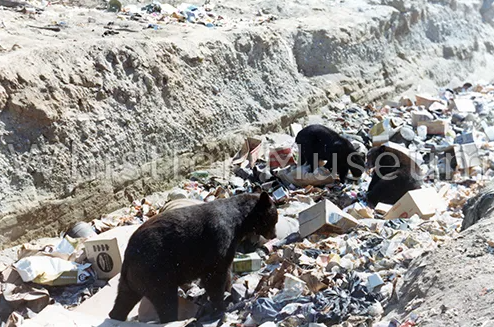The Beginning of Whistler Village and Its Bear-Related Challenges
Whistler Village’s origins often bring to mind a quirky fact many tend to overlook: the Village was initially developed on the site of a former landfill. This little-known detail frequently comes with tales of bears roaming around the dump, creating quite a stir during the formative years of the community.
Back in the early 1960s, the Alta Lake District Ratepayers Association sought to lease Crown land near the base of northern Whistler Mountain. The objective was practical—a centralized dumping ground for Alta Lake residents. Local help poured in; Valleau Logging Company volunteered their equipment and time, while community members regularly cleaned the area. Yet, despite these efforts, the presence of bears was inevitable, attracted by the leftover garbage.
The Intersection of Waste Management and Education: Myrtle Philip School
Although the dump was slated for relocation before the Whistler Village’s full development, it was still active where Myrtle Philip School (MPS) was built in 1976, raising concerns among parents and local officials alike.
In April 1976, with the school’s construction almost complete and plans to use the premises by summer, Roger Griffin was named principal. However, apprehensions grew quickly. By May, a concerned resident, Roberta Carson, reached out to the town council about the proximity of bears to the school. The council confirmed plans to move the dump by the end of May and promised close monitoring. If bears lingered by July, measures such as fencing the school’s play area would be considered.
Community and Wildlife Coexistence Against the Odds
At that time, the dump area was not just home to discarded refuse but was also surrounded by essential community services, including a liquor store and municipal offices housed in portable buildings. Bear sightings became so commonplace that local traffic signs, originally signaling deer crossings, were reportedly replaced with “Watch for Bear on Road” banners. Such signs themselves had a fleeting existence — rumored to have vanished as mysteriously as the bears! The local paper, Whistler Question, even reminded drivers in early May not to stop their cars just to watch the bears.
Moving the Dump and Bears’ Lasting Impact
By June 1976, progress was evident. John Hetherington of the Garbage Committee announced approval for a temporary landfill site off Cheakamus Lake Road. The old site’s cleanup was tendered out soon after. Official closure of the original dump near the school occurred in July, yet habits die hard—both people and bears continued to visit. One bear was amusingly noted “parading” on the liquor store’s porch, even pawing at the door to gain entry. Another settled around the old dump, sustained by those who still left garbage there.
School Life Without Fencing and Other Early Challenges
When classes officially began on September 7, 1976, bear sightings were thankfully less frequent, negating the need for a fenced play area. However, a new issue cropped up: dogs at the school during adult education evening sessions. This sparked a public reminder that no animals were permitted inside school buildings at any time.
Whistler’s Experience at a Glance: What Can We Learn?
The early days of Whistler Village illustrate a fascinating interplay between developing a growing community and peacefully coexisting with wildlife. It shows how logistics like waste management directly affect neighborhood safety and daily life—especially in places close to nature.
| Jaar | Event | Outcome |
|---|---|---|
| Early 1960s | Lease of Crown land for a dump in Alta Lake | Community uses dump; bears attracted to garbage |
| 1976, April | Construction nearing completion of Myrtle Philip School | Concerns about bears near school arise |
| 1976, June – July | Dump officially closed and moved; bears still present | Community monitors situation; fencing considered but not required |
| 1976, September | School opens; fewer bear sightings | School functioning without special animal-related barriers |
Implications for Transfers and Local Taxi Services
While this history might seem a world away from modern travel conveniences, it underlines the ongoing relationship between nature, community needs, and infrastructure development — a balance locals and visitors alike should keep in mind when booking rides around Whistler today.
Choosing reliable, well-informed local transfer services is key in areas where wildlife and town life intertwine closely. Platforms like LocalsRide.nl not only provide options to select your ride based on detailed preferences—such as vehicle model, driver ratings, and fare transparency—but also offer peace of mind when navigating regions with evolving landscapes.
Experience Outweighs All
Certainly, reading about bear sightings or school construction issues is one thing, but nothing beats firsthand experience. On LocalsRide, you can hire a vehicle with a licensed driver from trusted providers at fair prices. The platform’s extensive vehicle choices and clear service pricing help visitors and residents alike enjoy the best of the area without unexpected surprises or excessive costs.
Convenience, affordability, and transparency combine to empower every booking—whether a quick taxi ride to the airport, a limousine for a special occasion, or a roomy seater for groups exploring the city. Book now at LocalsRide.nl for the best offers.
Samenvatting
The early development of Whistler Village paints a vivid picture of community spirit, challenges with wildlife, and thoughtful adaptation to ensure safety and growth. From the days when bear sightings near Myrtle Philip School sparked concern to the strategic relocation of the dump, the story offers insight into how infrastructure and local life have long been intertwined.
Today, smooth and exact transportation services, including taxis and transfers, are vital in supporting both residents and tourists navigating Whistler. Platforms like LocalsRide.nl stand out by offering a transparent booking experience where customers can select vehicles with precision and confidence. This level of detail, combined with competitive fares and trusted drivers, makes exploring Whistler and its surroundings seamless and enjoyable.

